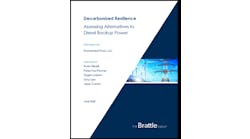ASHBURN, Va. – Data center operators in Northern Virginia leased 270 megawatts of capacity in 2018, more than doubling the previous record for annual absorption, according to a new report from Jones Lang LaSalle.
More than 80 percent of that volume was leased by hyperscale operators, the huge cloud and social media companies that have driven data center deals in recent years.
The epic activity in Northern Virginia accounted for 55 percent of all data center leasing nationally, according to Allen Tucker of Jones Lang LaSalle, who shared the 2018 leasing data in a keynote talk Thursday at the CAPRE 2019 Data Center Forecast East in Ashburn. Just four years ago, Northern Virginia represented about a quarter of national leasing.
The JLL data underscores how hyperscale computing is shaping the data center business, attracting new investment and guiding service provider strategies. These trends are writ large in Northern Virginia, where cloud platforms covet proximity to “Data Center Alley” in Ashburn.
Will this torrid pace of leasing continue in 2019? Recent earnings disappointments from Intel and NVIDIA have raised concerns among analysts about a lull in demand from cloud service providers. Most speakers at the CAPRE event expect strong demand will continue, especially in the second half of 2019.
“I don’t think it’s slowing down,” said Tucker. “We’re seeing tremendous pent-up growth and demand.”
Adapting Design: Bigger Is Better
Northern Virginia is the world’s largest data center market, and home to a fast-growing cloud computing cluster that features key infrastructure for Amazon Web Services, Microsoft, Google and Facebook.
The previous annual leasing record for Northern Virginia was 115 megawatts in 2017. But that milestone was history by mid-year, as the Ashburn market saw 157 megawatts of leasing in the second quarter of 2018, and the only question remaining was the final total, which was five times the volume of next best market in Phoenix (51 megawatts in 2018).
Tucker said the demand continued into the fourth quarter, and is expected to continue into 2019. A key to the market’s success has been its embrace of data center designs and construction practices that are optimized for hyperscale clients.
“In this market you have to build the right building,” said Tucker. “You have to build big early.”
Allen Tucker of Jones Lang LaSalle gives the keynote presentation at the CAPRE 2019 Data Center Forecast East held Jan. 31 in Ashburn, Va. (Photo: Rich Miller)
Several providers building new campuses in Ashburn have adjusted their designs to boost the capacity of their buildings. Vantage Data Centers now plans a 142-megawatt campus (up from 108 MWs), while Sabey Data Centers has added space to its newest building.
The trend toward larger scale will continue, according to Tucker. “There’s some who think the next generation of buildings may have 100,000 square foot data halls,” he said. That would continue a trend in which data center suites have grown to allow hyperscale customers to add capacity in larger chunks.
Strong but Lumpy?
Other market watchers also expect continued growth in Northern Virginia.
“We haven’t seen a slowdown,” said Kent Hill, Manager of Strategic Economic Development for Dominion Energy, the primary utility serving the market. “We connected 18 new data centers last year, and we expect that to continue this year.”
Hill noted that the neighborhood around Ashburn’s 1757 Golf Club, where the CAPRE event was held, reflects the demand. “We’re within a mile and a half of 11 substations, with six more on the way,” he said. “I don’t think there’s anyplace else in the country that has that kind of density in transmission.”
Analyst Sami Badri of Credit Suisse described how the development of 5G wireless services may impact data center growth in 2019 and 2020. (Photo: Rich Miller)
Perhaps the most nuanced view of hyperscale growth for 2019 came from securities analyst Sami Badri of Credit Suisse, who said cloud providers’ capital investments in data centers may decelerate in early 2019, but pick up again over the second half of the year.
“Nothing has changed in the last three months for hyperscalers,” said Badri, who said demand for network infrastructure to support the rollout of 5G wireless, the next-generation mobile standard that is expected to enable new low-latency data services. For the full year, cloud CapEx is likely to be similar to 2018, said Badri.
How FOMO and ROFO May Mold the Market
That would be continued good news for the data center industry, where construction has been going full throttle to keep pace with existing hyperscale demand. But the intermittent – or “lumpy” – nature of demand could delay a recovery for shares of data center REITs (real estate investment trusts), which typically struggle when interest rates are rising.
The deal volume in Northern Virginia market is being accelerated by FOMO — the fear of missing out. As the appetite for data center space remains high, both users and developers are looking to play a longer game. To accommodate larger requirements, developers are buying more land, and seeking to reserve expansion space in strategic markets, while deploying capital on a pay-as-you-go-basis.
This has created a land grab around Ashburn, with data center providers buying up development sites, boosting the price of land.
Hyperscale players are already investing in reserving huge chunks of future capacity through “right of first offer” (ROFO) deals with developers, who offer existing tenants first shot at negotiating deals for new space before it is offered to the broader market.
“We now have the hyperscale guys wanting to control the vacancy in their building to control growth,” said Tucker, who said marquee tenants have ROFO agreements for about 260 megawatts of capacity in Northern Virginia, nearly equivalent to the entire leasing volume for 2018.
One of the panels at the CAPRE Forecast event featured (from left) Paul Himes of Himes Associates, GIGA Data Centers CEO Jake Ring, Hostway CEO Emil Sayegh, and Jeffrey Moerdler of Mintz Levin. (Photo: Rich Miller)
Cloud platforms have also using hybrid lease strategies, in which they lease entire buildings as powered shells (finished buildings with undeveloped space inside, with the power and fiber connectivity already in place) and then build up finished data center space in chunks. Both QTS and Digital Realty have used this structure to allow tenants to reserve future capacity.
Both approaches are effectively looser versions of pre-leasing that provide predictability for future growth. This has benefits for both tenants and landlords. But Badri of Credit Suisse noted that this is a new market dynamic. “We actually have not seen how a massive backlog in a large facility under construction could stall,” resulting in deployment delays or unfilled inventory, said Badri.
Land Pricing Drives New Data Center Geography
So where is the market headed? That’s a question that applies to geography as well as activity, given the dwindling supply of land and rising cost-per-acre in Ashburn. There was some discussion at the CAPRE event about whether prices for land had exceeded $2 million per acre. Prices vary dependent upon the state of a property and whether it is vacant land or houses a building or existing business. Recent deals illustrate the range:
- In July, CyrusOne bought a 10-acre property in Sterling, Va. with a 154,000 square foot existing structure, which will be retrofitted for data center use. The company paid $26 million, or $2.6 million per acre, according to SEC filings.
- In 2018 an affiliate of Cologix paid a reported $1.68 million per acre for a property the current site of the Christian Fellowship Church in Ashburn, a 23-acre site featuring open land and an existing building, which will be demolished once the church relocates.
- Deal prices for vacant land have reached as high as $1.4 million for several deals in 2018, market sources say. No known deals for vacant land have exceeded $2 million (to date).
The growing focus on sites with existing buildings mirrors the trend in Santa Clara, the leading market in Silicon Valley, as major development sites have grown scarce in Santa Clara, prompting data center developers to demolish structures to make way for data center campuses.
“In short, there’s nothing left (in Ashburn),” said Jamie Jelinek, a vice president at CBRE, on a panel at the CAPRE event. “You’ve got a few small pockets, and everything has hair on it,” he said, using industry jargon for properties with wetlands or needing extensive site work.
“The question is where’s next?,” said Jelinek. “We’ve seen the action move out towards Leesburg and Arcola and Prince William.”
Tucker noted that Prince William County had 12 megawatts of leasing in 2018. While that’s dwarfed by the activity in Ashburn, it is more than many other major markets around the country.
“Watch Prince William,” said Tucker. “Providers are already buying ground there.”
The emergence of new sub-markets in Northern Virginia isn’t likely to affect the data center business in Data Center Alley in Ashburn, according to market watchers.
“This is not a zero sum game, where Loudoun’s going to give anything up,” said Lee Kestler, Chief Commercial Officer of Vantage Data Centers. “The bottom line is that land and shell are 8 to 10 percent of costs. When prices are rising, that’s a byproduct of the success we’ve seen in Loudoun County.
“I’m very optimistic,” Kestler added. “This market is going to continue to hum.”






